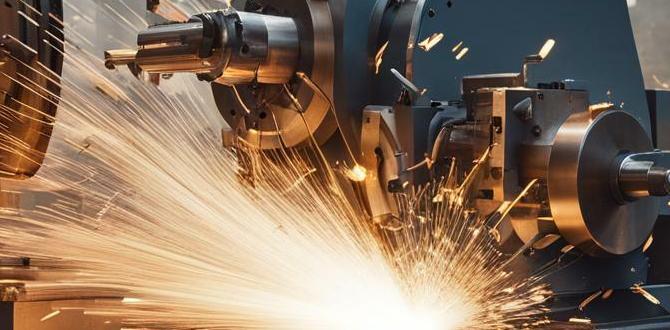This 1/8 inch carbide end mill is a precision tool, perfect for detailed work in brass. Its specific design ensures accuracy and efficiency, making it ideal for hobbyists and professionals tackling tight tolerance projects.
So, you’ve got a brass project and need to make some really precise cuts. Ever looked at those tiny, shiny cutting tools and felt a bit overwhelmed? Don’t worry, you’re not alone! Many beginners get a bit intimidated by the sheer variety of machining tools out there. But when it comes to working with brass, especially for intricate details or when you need super-accurate dimensions, a specific type of tool can be a real game-changer: the 1/8 inch carbide end mill, particularly those designed for brass.
Think of it like having the perfect paintbrush for a delicate detail on a painting. This small end mill is exceptionally good at what it does, and when you use it correctly, it can make your brass projects look incredibly professional. We’re going to break down exactly what makes this tool so special, how to choose the right one, and how to use it safely and effectively. Get ready to unlock some serious precision in your workshop!
What is a Carbide End Mill?
Before we dive into the specifics of the 1/8 inch variety for brass, let’s quickly touch on what an end mill even is. An end mill is a type of milling cutter. You can think of it as a specialized drill bit that can also cut horizontally, not just plunge downwards. They are used in milling machines (both manual and CNC) to machine grooves, slots, pockets, and contours into materials.
Why “carbide,” you ask? Carbide, specifically tungsten carbide, is an extremely hard and durable material. Tools made from carbide can cut harder materials and last much longer than those made from High-Speed Steel (HSS). For precision work and cutting tough materials like brass, carbide is often the preferred choice due to its superior wear resistance and ability to maintain a sharp edge.
Why a 1/8 Inch Carbide End Mill for Brass?
Now, let’s get to the heart of it: the 1/8 inch carbide end mill and why it’s often called a “genius brass tool.”
- Precision and Detail: A 1/8 inch (which is approximately 3.175 mm) diameter is quite small. This allows for incredibly fine detailing, intricate patterns, and tight-tolerance work that larger end mills simply can’t achieve.
- Brass Machining Properties: Brass is a relatively soft and “gummy” metal compared to steel. While it machines well, it can also be prone to “built-up edge” (BUE), where material sticks to the cutting edge. Specialized end mills designed for brass, often with specific flute geometries and polished flutes, help to minimize this.
- Carbide’s Edge: The hardness of carbide means it can hold a sharp edge for longer, which is crucial for maintaining precision in delicate cuts. It also handles the heat generated during machining better than HSS.
- Specific Design for Brass: Many 1/8 inch carbide end mills marketed for brass feature bright-polished flutes. This smoother surface finish helps chips of brass flow away from the cutting edge more easily, reducing friction, heat, and the chance of BUE. Some might also have a specific number of flutes (often 2 or 4) and hook/rake angles optimized for softer, chip-forming materials like brass.
The “Genius” Factor: Tight Tolerances and Specialization
The real “genius” in this tool often comes down to its specialization. When a 1/8 inch carbide end mill is specifically engineered with features like a 10mm shank (for better rigidity in the collet or holder) and an extra-long flute length, it becomes a powerful tool for specific applications. This combination allows for deeper cuts or reaching into recessed areas while maintaining the stability and precision needed for tight tolerance machining. For brass, this means you can engrave very fine lines, create precise slots for pins or gears, or mill out detailed cavities without worrying about the tool deflecting or wearing down too quickly.
Choosing Your 1/8 Inch Carbide End Mill for Brass
Not all 1/8 inch carbide end mills are created equal, especially when you’re targeting brass. Here’s what to look for:
Shank Diameter
1/8 Inch Shank: For the smallest, most delicate work, a 1/8 inch shank might be used. However, this can sacrifice rigidity.
1/4 Inch Shank: A common and more rigid option, offering good stability for general-purpose work.
10mm Shank: This is often a preferred choice for precision milling. A 10mm shank provides significantly more rigidity than a 1/4 inch shank, which is crucial for maintaining accuracy, especially in longer tools or during heavier cuts. This is a key feature when aiming for tight tolerances.
Flute Count
2 Flutes: Generally excellent for softer materials like brass and aluminum. The increased chip space between the two flutes helps prevent clogging and allows chips to evacuate easily. This is often recommended for brass.
4 Flutes: Offer a smoother finish and can handle slightly more material removal. However, they have smaller chip gullets, which can be a problem with “gummy” materials like brass if not managed properly (e.g., by using lighter cuts and good chip evacuation).
Flute Finish
Polished Flutes: As mentioned, for brass, look for end mills with highly polished flutes. This reduces friction and prevents the brass from sticking to the cutting edge, leading to cleaner cuts and longer tool life.
TiN (Titanium Nitride) or Other Coatings: While common on end mills for steel, coatings aren’t always necessary or even beneficial for brass. A polished, uncoated carbide end mill is often best.
End Type
Square End: The most common type. Used for creating flat-bottomed slots, pockets, and profiles.
Ball End: Has a rounded tip, used for creating 3D contours, fillets, and rounded slots.
Corner Radius: A square end with a small radius on the corners. This adds strength to the tool and prevents sharp corners in the workpiece, which can be desirable for stress distribution.
Length
Standard Length: Suitable for most typical milling operations.
Extra Long: An extra-long flute length allows you to reach deeper into a workpiece or machine to a greater depth in a single pass. This requires extra care due to potential tool deflection. For a 1/8 inch end mill, “extra long” is relative, but it means the cutting portion of the tool is significantly longer than standard for its diameter, demanding a very rigid setup.
Applications for a 1/8 Inch Carbide End Mill in Brass
This specialized tool shines in a variety of applications:
Jewelry Making: Creating intricate bezels, settings, and decorative elements where precision is paramount.
Model Engineering: Machining small gears, housings, and components for intricate scale models.
Prototyping: Quickly milling out precise prototypes or custom parts for electronic enclosures or mechanical devices.
Engraving and Sign Making: Producing detailed lettering or custom designs on brass plates or components.
Custom Fixturing: Machining precise pockets or features in small jigs and fixtures.
Musical Instrument Parts: Crafting detailed components for brass instruments.
Setting Up for Success: Safety and Operation
Using any cutting tool requires caution and proper setup. Here’s how to approach using your 1/8 inch carbide end mill in brass safely and effectively.
Safety First!
Eye Protection: Always wear safety glasses or a face shield. Metal chips can fly unexpectedly.
Clothing: Avoid loose clothing, jewelry, or anything that could get caught in the rotating machinery. Tie back long hair.
Machine Guarding: Ensure all machine guards are in place and functioning correctly.
Secure Workpiece: Your brass workpiece MUST be securely clamped or fixtured. It should not move at all during machining.
Tool Security: Ensure the end mill is securely held in the collet or tool holder. A loose tool can be incredibly dangerous.
Coolant/Lubrication: For brass, a light mist of cutting fluid or even WD-40 can help lubricate the cut, reduce heat, and clear chips. Use as recommended for your specific material and tooling.
Machine Setup: The Foundation of Precision
A rigid machine setup is crucial for precision milling, especially with small tools.
Milling Machine: A sturdy milling machine (benchtop or floor model) is ideal. While a CNC mill offers automated precision, a well-maintained manual mill can also produce excellent results.
Collet Chuck: Using a good quality collet chuck (e.g., R8 or ER type for larger machines) for your 1/8 inch end mill is highly recommended over a standard drill chuck. Collets provide a much more concentric and rigid grip on the tool shank, minimizing runout and vibration.
Workholding:
Vise: A good quality machine vise is essential. Ensure it’s clean, square, and mounts securely to the machine table.
Clamps: For irregular shapes, use clamps that grip the workpiece firmly to the machine table or a fixture plate.
Tooling:
Collets: If using an ER-style system, a 1/8 inch (or 3.175mm) collet is required. The closer the collet size is to the shank diameter, the better the grip.
Holder: The collet fits into a tool holder, which then mounts into the milling machine spindle.
Machining Parameters: Finding the Sweet Spot
These are starting points; you’ll often refine them based on your specific machine, the exact brass alloy, and the tool.
Spindle Speed (RPM): For 1/8 inch carbide end mills in brass, a good starting point is often in the range of 8,000 to 15,000 RPM.
Calculation Example: You can use online calculators or formulas. A common rule of thumb for carbide in brass might be a surface speed (SFM) around 200-400 SFM.
SFM = (RPM Diameter) / 3.82
So, RPM = (SFM 3.82) / Diameter
For 300 SFM and a 1/8 inch diameter (0.125 inches):
RPM = (300 3.82) / 0.125 = 9168 RPM. Let’s round up to 10,000 RPM as a starting point.
Feed Rate: This is how fast the tool moves through the material.
Chip Load: A good way to think about feed rate is “chip load” – the thickness of the material each cutting edge removes per revolution. For a 1/8 inch, 2-flute carbide end mill in brass, a chip load of around 0.001 to 0.002 inches per tooth is a reasonable starting point.
Feed Rate (IPM) = Chip Load Number of Flutes RPM
Using 0.0015 inch chip load, 2 flutes, and 10,000 RPM:
Feed Rate = 0.0015 2 10,000 = 30 IPM (Inches Per Minute). Start conservatively, maybe at 20 IPM, and increase if the cut is smooth and chips are well-formed.
Depth of Cut (DOC): For a delicate 1/8 inch tool, especially if it’s extra-long, it’s best to take shallow depths of cut, especially in the Z-axis (plunging or cutting down).
Radial DOC (side cutting): You can often take a larger radial DOC.
Axial DOC (plunging/down cutting): Start very conservatively, perhaps 0.010 to 0.020 inches for plunging operations. For removing material in pockets, experiment with up to 0.050 inches or more, depending on rigidity. Listen to the cut – if it sounds strained or starts chattering, reduce the DOC or feed rate.
Climb Milling vs. Conventional Milling:
Climb Milling: The cutter rotates in the same direction as the feed. This generally produces a better surface finish, lowers cutting forces, and is often preferred for softer materials like brass and when using CNC.
Conventional Milling: The cutter rotates against the direction of feed. This can be more stable on older or less rigid machines.
For precision and finish with your 1/8 inch end mill, try climb milling if your machine supports it.
Step-by-Step Milling Process (Example: Pocketing in Brass)
Let’s imagine you need to mill a small, precise rectangular pocket in a piece of brass.
1. Secure the Brass: Mount your brass workpiece securely in the milling vise. Ensure it’s clean and the vise jaws have good contact. If possible, indicate the block to ensure it’s “square” to the machine axes.
2. Install the End Mill: Insert the 1/8 inch carbide end mill into the appropriate collet. Tighten the collet securely in the collet chuck. Mount the chuck into the milling machine spindle.
3. Set Zero (X and Y): Using an edge finder or indicator, locate the edges of your brass workpiece to set your X and Y zero points on the machine’s DRO (Digital Readout) or CNC controller.
4. Set Zero (Z): Lower the spindle until the tip of the end mill gently touches the top surface of your brass. Engage the spindle. Carefully advance the Z-axis down until you just feel the tip make contact. A piece of paper can be used as a feeler gauge. Once contact is made, set your Z zero. For precision, a touch probe is ideal if available.
5. Program/Set Toolpath: If using CNC, program your pocketing operation. For manual milling, you’ll be moving the handwheels. Consider using a “pocketing” or “contour” toolpath that moves around the perimeter of the pocket, then steps inwards.
6. Begin the Cut (First Pass):
Start the spindle at your chosen RPM (e.g., 10,000 RPM).
Apply cutting fluid (optional but recommended).
Begin feeding the tool into the brass at your chosen feed rate (e.g., 20 IPM) and a shallow depth of cut for the first pass (e.g., 0.010 inches).
If manual, advance the X or Y handwheel slowly and steadily, moving the tool. For pocketing, you might move the X axis, then step the Y axis, then move back in X, etc., or use a spiral toolpath.
Listen for smooth cutting sounds. Avoid forcing the tool.
7. Subsequent Passes:
Once the first pass is complete, carefully retract the tool in the Z-axis.
Increase the depth of cut to your desired level (e.g., 0.020 or 0.040 inches) and incrementally advance in the X or Y direction to remove more material, repeating the process.
Continue taking passes, increasing the depth incrementally, until the pocket reaches its final dimensions.
8. Finishing Pass: For the very last pass to achieve final dimensions and a good surface finish, consider taking a lighter depth of cut (e.g., 0.005 inches) and potentially a slightly slower feed rate.
9. Clean Up: Once the pocket is milled to size, retract the tool fully, turn off the spindle, and clean the machine and workpiece of chips and coolant.
Troubleshooting Common Issues
Even with the right tool, you might run into a few snags.
Brass Sticking to the Tool (BUE):
Cause: Insufficient lubrication, too slow a spindle speed, or poor chip evacuation.
Solution: Increase spindle speed slightly, use more cutting fluid, ensure flutes are clean, or try a slightly higher feed rate to create a more robust chip. Ensure you’re using a tool specifically designed for brass with polished flutes.
Chatter or Vibration:
Cause: Too deep a cut (DOC or feed rate), loose toolholding, worn machine components, or workpiece not secured.
Solution: Reduce depth of cut or feed rate, ensure collet and tool are seated properly, check for play in machine axes, and ensure the workpiece is rigidly clamped.
Poor Surface Finish:
Cause: Tool wear, incorrect cutting parameters, or BUE.
Solution: Sharpen or replace the tool, adjust RPM and feed rate (try increasing RPM and feed proportionally), or address BUE. A final “sweep” pass with a very light depth of cut can also improve finish.
Tool Breaking:
Cause: Excessive feed or depth of cut, hitting an unseen obstruction, or tool fatigue.
* Solution: Always start with conservative parameters. Understand your machine’s limits. Ensure you have accounted for all features in your design.
Key Specifications for a “Genius Brass Tool” (Example)
To give you an idea of what to look for when buying, here’s a typical spec sheet for a high-quality 1/8 inch end mill optimized for brass





